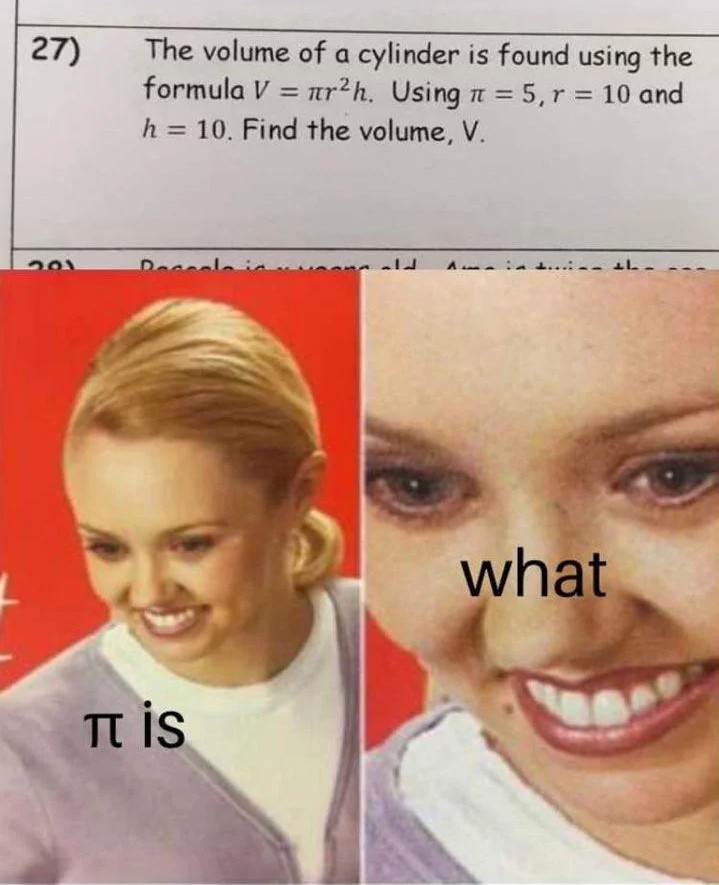this post was submitted on 21 Apr 2024
405 points (96.3% liked)
Science Memes
11542 readers
1687 users here now
Welcome to c/science_memes @ Mander.xyz!
A place for majestic STEMLORD peacocking, as well as memes about the realities of working in a lab.

Rules
- Don't throw mud. Behave like an intellectual and remember the human.
- Keep it rooted (on topic).
- No spam.
- Infographics welcome, get schooled.
This is a science community. We use the Dawkins definition of meme.
Research Committee
Other Mander Communities
Science and Research
Biology and Life Sciences
- [email protected]
- [email protected]
- [email protected]
- [email protected]
- [email protected]
- [email protected]
- [email protected]
- [email protected]
- [email protected]
- [email protected]
- [email protected]
- [email protected]
- [email protected]
- [email protected]
- [email protected]
- [email protected]
- [email protected]
- [email protected]
- [email protected]
- [email protected]
- [email protected]
- [email protected]
- [email protected]
- [email protected]
- !reptiles and [email protected]
Physical Sciences
- [email protected]
- [email protected]
- [email protected]
- [email protected]
- [email protected]
- [email protected]
- [email protected]
- [email protected]
- [email protected]
Humanities and Social Sciences
Practical and Applied Sciences
- !exercise-and [email protected]
- [email protected]
- !self [email protected]
- [email protected]
- [email protected]
- [email protected]
Memes
Miscellaneous
founded 2 years ago
MODERATORS
you are viewing a single comment's thread
view the rest of the comments
view the rest of the comments

For the purpose of teaching young school kids how to substitute real values for constants/variables, does it matter? π is a constant, but the value you use for it in exams and real life will not be the same, or the actual correct value. Getting students used to the idea that even constants can have varying values in exams or software is useful.
In my exams π had values ranging from 3, 3.1 to whatever the calculator had.
galso ranged from 9.8 to 10, although in fairnessgis not a constant.At least setting it to 5 can spark debate around what a more reasonable approximation should be.
OP's problem isn't even wrong.
It's just assuming that π is 5 in this specific scenario, just like it's reasonable to assume the existence of a spherical cow in a frictionless environment. Yeah, if you use the results of this problem to develop a real cylinder you're going to have a bad time but nobody is doing that all what's the problem?
Nobody is saying that from this point in time and going forward π = 5 and now math is broken forever. People need to chill
If it's teaching grade school kids, I would argue it is problematic, only as to not draw confusion on reassigning π away from it's widely accepted consistent value of ~3.14 for most applications. Once you start getting into theoretical physics and the like, that's a different story. Math is already a tough subject for many kids and this would just throw another wrench into the learning curve. I'd argue to only start debating the fundamentals and theory after a firm grasp of the fundamentals has been established and practiced repeatedly, preferably in upper level courses.
I dont quite know what grade school is, but if you mean 12-15yo students, i dont think its that much more confusing:
I liked math though, so perhaps I am just biased there.
More or less that age, yeah. I'm guessing you're outside the US, typically grade school here refers to Kindergarten to 12th grade (basically 5y to 17/18).
Perhaps this is an American methodology, but we were always taught that π is intended to represent the constant of 3.14 as it applies to circles in geometry and trigonometry, while various variables of x/y/z/etc were values to either be input or solved for. It wasn't until Calculus that it was suggest that π could be variable dependent on other factors in a certain context, but that was usually pretty rare.
And yeah I enjoy math as well, but I also helped tutor my peers who didn't grasp it, so I can understand why it was taught that way (that and our education system is interesting, for lack of a better term).
Yup, Australian, and thats primary+secondary school here. Im only harping on the test/exam thing because i vaguely recall having some tests were π was set to a specific value like 3.1, and that if you used the calculator π, all your answers ended slightly off. It wasnt anything to do with π being a variable, just the you had better read the exam question carefully and that blindly typing the equation into the calculator would not always be the answer.
I think i have typed π more times today than the last 15 years since I left highschool :D
Ah gotcha. It's been a while but as I recall, on tests without calculators we were usually told to use 3.14 and round our answers to the nearest hundredth, though some teachers were more flexible if you were pretty close but slightly off in the decimals, while tests with calculators were pretty stringent on being precise. And yeah, I remember pretty early to ensure the decimal lengths because I tended to use the calculator's length of π instead of hundredths or thousandths or whatever and it botched my answers after rounding off.
I feel ya there, though I'm starting up school again in the fall so this is getting me somewhat excited for math classes again.